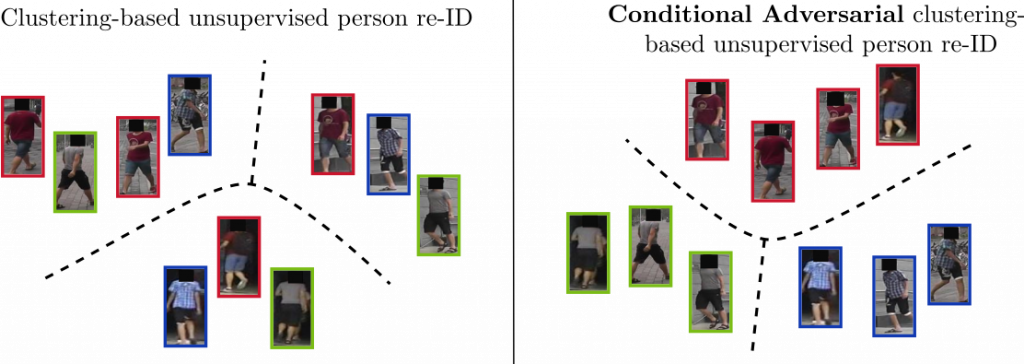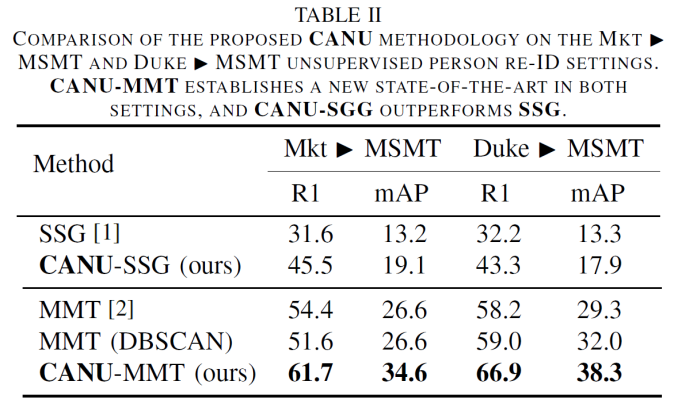by Guillaume Delorme, Stéphane Lathuilière, Radu Horaud and Xavier Alameda-Pineda
Presented at ICPR, 2021
[arXiv] [HAL] [poster] [slides] [code]

Intuition of CANU-ReID. When adapting to a new dataset via the clustering-and-finetunning method, identities are mixed up. Our conditional adversarial methodology leads to a result that is more robust to dataset shifts.
Abstract: Unsupervised person re-ID is the task of identifying people on a target dataset for which the ID labels are unavailable during training. In this paper, we propose to unify two trends in unsupervised person re-ID: clustering & fine-tuning and adversarial learning. On one side, clustering is used to group the training images into pseudo-labels, and then use this pseudo-labels to fine-tune the feature extractor. On the other side, adversarial learning is used, inspired from domain adaptation, to match distributions from different domains. We propose to model each camera of the target dataset as a domain, and aim to learn domain-independent features. Straightforward adversarial learning yields negative transfer, and we introduce a conditioning vector to mitigate this undesirable effect. In our framework, the centroid of the cluster to which the visual sample belongs is used as conditioning vector of our conditional adversarial network. This choice is motivated because it is independent of the number of clusters and permutation invariant (the cluster order does not matter). To our knowledge, we are the first to propose the use of conditional adversarial networks for unsupervised person re-ID. We evaluate the proposed architecture on top of two state-of-the-art clustering-based unsupervised person re-identification (Re-ID) methods on four different experimental settings with three different datasets, and set the new state-of-the-art performance on all four of them.
Contributions:
- We investigate the impact of a camera-adversarial strategy in the unsupervised person re-ID task.
- We realize the negative transfer effect, and propose to use conditional adversarial networks.
- The proposed method can be easily plugged into any unsupervised clustering-based person re-ID methods. We experimentally combine CANU with two clustering-based unsupervised person re-ID methods, and propose to use their cluster centroids as conditioning labels.
- Finally, we perform an extensive experimental validation on four different unsupervised re-ID experimental settings and outperform current state-of-the-art methods by a large margin on all settings.

Results: We report unsupervised Re-ID performance on widely used datasets: Market-1501 [3] (Mkt), DukeMTMC-reID [4] (Duke) and MSMT17 (MSMT) [5].
References:
[1] Y. Fu, Y. Wei, G. Wang, Y. Zhou, H. Shi, and T. S. Huang, “Self-similarity grouping: A simple unsupervised cross domain adaptation approach for person re-identification,” in IEEE ICCV, 2019.
[2] Y. Ge, D. Chen, and H. Li, “Mutual mean-teaching: Pseudo label refinery for unsupervised domain adaptation on person re-identification,” in ICLR, 2020.
[3] L. Zheng, L. Shen, L. Tian, S. Wang, J. Wang, and Q. Tian, “Scalable person re-identification: A benchmark,” in IEEE ICCV, 2015.
[4] E. Ristani, F. Solera, R. Zou, R. Cucchiara, and C. Tomasi, “Performance measures and a dataset for multi-target, multi-camera tracking,” in ECCV Workshops, 2016.
[5] L. Wei, S. Zhang, W. Gao, and Q. Tian, “Person transfer gan to bridge domain gap for person re-identification,” in IEEE CVPR, 2018.






